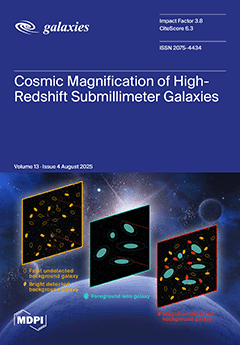In this study, we present analysis of
TESS photometry, spectral energy distribution (SED), high-resolution spectroscopy, and spot modeling of the
CVn-type star AL Col (HD 46462). The primary objective is to determine its fundamental physical parameters and investigate its surface activity
[...] Read more.
In this study, we present analysis of
TESS photometry, spectral energy distribution (SED), high-resolution spectroscopy, and spot modeling of the
CVn-type star AL Col (HD 46462). The primary objective is to determine its fundamental physical parameters and investigate its surface activity characteristics. Using
TESS short-cadence (120 s) SAP flux, we identified a rotational frequency of 0.09655
(
d). Wavelet analysis reveals that while the amplitudes of the harmonic components vary over time, the strength of the primary rotational frequency remains stable. A SED analysis of multi-band photometric data yields an effective temperature (
) of 11,750 K. High-resolution spectroscopic observations covering wavelengthrange 4500–7000 Å provide refined estimates of
= 13,814 ± 400 K,
= 4.09 ± 0.08 dex, and
= 16 ± 1 km s
−1. Abundance analysis shows solar-like composition of O
ii, Mg
ii, S
ii, and Ca
ii, while helium is under-abundant by 0.62 dex. Rare earth elements (REEs) exhibit over-abundances of up to 5.2 dex, classifying the star as an Ap/Bp-type star. AL Col has a radius of
, with its H–R diagram position estimating a mass of
and an age of
Gyr, indicating that the star has slightly evolved from the main sequence. The
TESS light curves were modeled using a three-evolving-spot configuration, suggesting the presence of differential rotation. This star is a promising candidate for future investigations of magnetic field diagnostics and the vertical stratification of chemical elements in its atmosphere.
Full article





